Subscribe to blog updates via email »
April 2020 Income Report
An audio version of this income report is available to Patreon backers of certain levels »
April’s revenues were $5,283, up from March’s $3,099. Profits were $4,003, up from March’s $1,959.
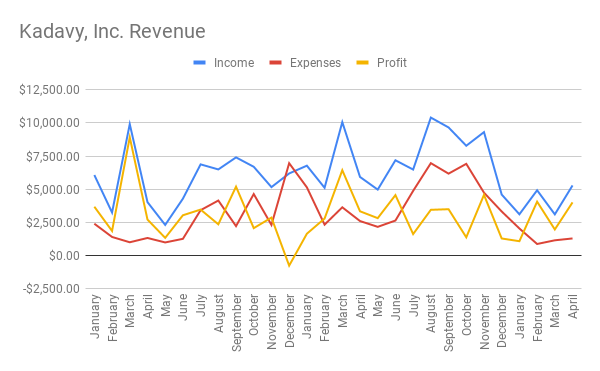

WANT TO WRITE A BOOK?
Download your FREE copy of How to Write a Book »
(for a limited time)
Record self-published book profits
I had a record profit on self-published book sales this month: $2,529. The previous record was in December 2019 at $1,605.
The caveat is that a good portion of that profit is from the launch of the Preview Edition of Mind Management, Not Time Management, which brought in $1,580.
Taking that book out of the catalog would yield a profit of $949, which is still 73% more than the $550 average over the past twelve months.
Chapters added to Preview Edition of Mind Management, Not Time Management
Speaking of Mind Management, Not Time Management, I continue to deliver new chapters of the Preview Edition, on the promised schedule.
The latest chapter is Chapter 6: Creative Systems. It’s all about building systems that drive your creative projects forward, on autopilot.
Three of the planned seven chapters are now available buy a copy while you can. I’ll be shutting down sales in a few weeks, as I prepare to release the first edition in the fall.
Amazon Ad spend ramping up
I spent $639 on Amazon Ads, which is a big ramp-up after cutting them out completely at the start of the year. I cut out all keyword ads, leaving only Lockscreen ads.
This way, I can get a better feel for how well the numbers I see in the dashboard translate to my actual sales. I’ve run some analysis, and the verdict is that Amazon’s Lockscreen ads reporting is, in fact, waaaaay off.
Do Amazon’s Lockscreen ads really drive sales?
Looking at this graph, you can see that clicks generated by Lockscreen ads (advertising The Heart to Start) strongly correlate with Kindle sales. When I get more clicks, I get more sales. When I stop getting clicks, the sales stop a few days later.
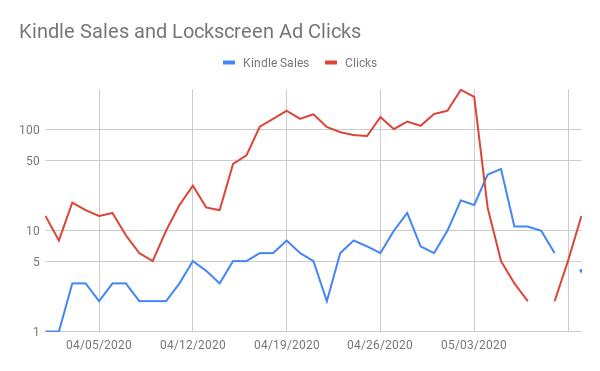
However, these are just the Kindle sales reported in the KDP dashboard. The sales reported in the Amazon Ads dashboard tell a different story. The red line below shows you how many sales were reportedly generated by Amazon Ads. Relatively speaking, very few!
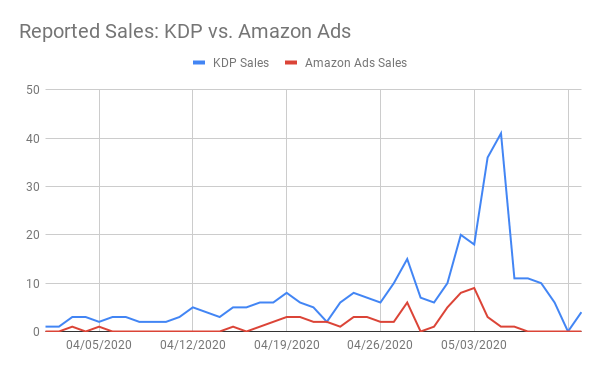
From this data, I’m confident that my Lockscreen ads are, in fact, driving Kindle sales. There were no big events to which I would attribute so many organic sales.
Also, you can see from the sales vs. clicks graph that I shut down Lockscreen ads – in preparation for a pricing promotion – and the sales dropped along with the drop in clicks.
By the way, this correlation is even stronger than it appears in the graph, because that final peak in the blue line is actually a spike in sales from the pricing promotion. (Here it is again, this time with the reported Amazon Ads included, in yellow)
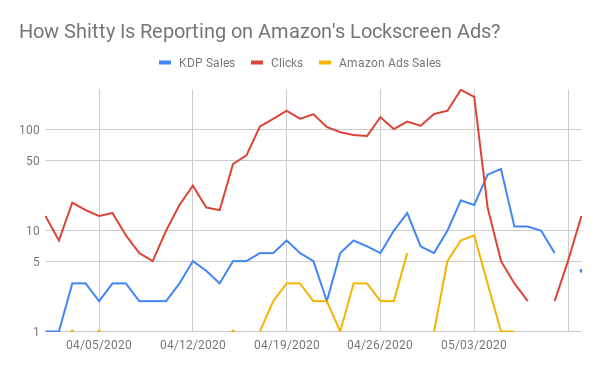
How bad (or good) is Amazon Lockscreen Ads reporting?
So, is Amazon’s Lockscreen Ads reporting completely useless? I’m fairly confident that it’s not completely useless.
Take, for example, an ad that was running the Arts & Crafts category. This was reporting a horrible ACoS of about 300%. Meanwhile, other ads were reporting much lower ACoS’s, from 75% to 120%.
As I learned from Brian Meeks’s Mastering Amazon Ads, “a click is a click is a click.” Basically, don’t pay attention to ACoS, just get cheap clicks.
At least in this case, that doesn’t seem to be true. Notice what happened when I turned off this high-ACoS Arts & Crafts ad. All of those clicks I was getting disappeared, but the sales kept climbing.
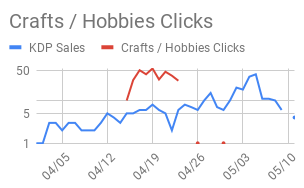
Also, notice that those clicks from this high ACoS ad track with a big gap between clicks and sales. Here’s the Kindle sales versus clicks graph again.

These data suggest that the ACoS reporting of Lockscreen ads is inaccurate, but the ACoS reported seems to have some relationship with reality.
Perhaps it’s that Amazon Ads tracks sales that happen quickly, but if it takes a couple of days for someone to read a sample and decide to buy, they don’t properly attribute the sale.
If this were the case, I’d expect that if an ad is relevant, some sales would happen quickly, and some would take a few days to occur. If an ad is relevant, fewer sales would happen overall.
How well-targeted are Amazon Lockscreen Ads?
By the way, I finally got a Kindle Paperwhite. Normally, I would pay extra not to have ads, but I went with the cheaper options just so I could see what these Lockscreen ads are really like.
The books they’ve been advertising to me are wildly irrelevant:
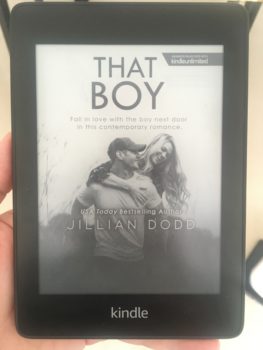
How irrelevant are Amazon’s Lockscreen Ads? This irrelevant. Not exactly my genre.
In fact, they even advertised to me my own book!
tfw your kindle advertises to you your own book pic.twitter.com/IMbp8G9igJ
— ? David Kadavy (@kadavy) May 5, 2020
Okay, that was pretty cool, but then I remembered: Wait, I already bought my own book. Why the hell are they advertising it to me again?
In short, Amazon Lockscreen ads have a lot of room for improvement in terms of reporting and targeting. But, they do drive sales for me, so I’ll keep using them.
Continuing to invest in Twitter
Twitter continues to be my main focus, after my morning writing session on Mind Management, Not Time Management.
It feels silly to write that. After all, isn’t Twitter every writer’s worst enemy? In terms of being a distraction, it certainly can be.
However, I’m discovering that Twitter is an incredibly powerful writing tool, if used right. It gives you a chance to get instant feedback on your ideas. If you pay attention to the engagement on your tweets, you can use that feedback to greatly improve your short-form writing skills.
The more I look at Twitter, the more questions I have
As a review, somewhere around the turn of the year, I looked at my Twitter and noticed something: I had tweeted more than 30,000 times, and I had never had a viral tweet. I had been on the platform for thirteen years, yet my follower numbers had been stuck for a couple of years. Meanwhile, my engagement was steadily dropping. With 20,000 followers, it seemed strange that I frequently had tweets with no likes at all.
I had to ask myself an uncomfortable question: Maybe I’m really bad at Twitter? That’s not terrible in itself, but if you’re a writer, and you’re bad at Twitter, that leads to another uncomfortable question: Maybe I’m also a bad writer?
I started off the year only using Twitter at scheduled times, composing and scheduling my tweets separately. I also began studying rhetoric, with the aim of improving my short-form writing.
For the first time ever, I started to pay attention to the performance of my Twitter account. Were my tweets getting impressions and engagement? Were those impressions and engagements leading to growth in followers? Was it helping me sell books, or build my email list?
But the more I asked these questions, the harder it was to find answers. Why were some tweets getting lots of impressions, or no impressions, with seemingly nothing to do with likes and retweets? Why were links that I shared getting few impressions, and even fewer clicks? Why was my follower count continuing to drop, even as I saw new followers coming in?
What I’ve learned about using Twitter in the past four months
Now four months into my deep dive into Twitter, I’m starting to learn a few things.
First, what is Twitter for? For me:
- Twitter is primarily for testing my ideas. My high-performing tweets graduate into Love Mondays emails, podcast episodes, or even books. This also works in reverse. Ideas I come across in writing these larger products also get tested on Twitter.
- Twitter is also for improving my short-form writing. After failing a big podcast appearance, I also had to ask myself: Maybe I’m not that good at talking about my ideas in podcast interviews? In editing interviews for my podcast, I’ve also found a big difference amongst guests in their abilities to talk about ideas. For some, it’s very easy to find compelling quotes and sound clips. For others, not so much. If it works as a tweet, generally, it will work as a sound bite, too.
- A byproduct of Twitter is audience growth. I have to keep reminding myself that any aims at growing my audience through Twitter are mere byproducts of using Twitter. I say I have to remind myself of that, because I’ve spent an enormous amount of attention seeing how to grow my Twitter following, and how that following translates to growth in other channels, such as my podcast listenership and email list. But, sometimes you have to look at the trees before you can see the forest.
Now, what have I learned about actually using Twitter?
Engagements lead to impressions
At first, I was confused by Twitter’s “engagement rate” graph, in Twitter Analytics. After all, it seemed that if you got engagements, it led to more impressions, so wouldn’t the engagement rate automatically drop toward a mean as you got more impressions?
No. Some tweets simply get way more engagement. That leads to more impressions, but the engagement rate of such tweets remains high.
All kinds of engagement matter
For the sake of testing my ideas, I’m mostly interested in Likes and Retweets. But, other kinds of engagement also matter.
Replies, detail expands, poll votes, media views, and profile clicks – all of these bring up your engagement rate, and all of them bring up your impressions.
If my main goal is to improve my writing, this could be a distraction. After all, I want engagement for my ideas, not because I put up a compelling poll.
Additionally, polls and compelling questions could alienate people who follow for good writing. So, there’s a balance to be struck here. Not sure of the ideal ratio.
Engagements create a halo effect for future tweets
The more engagement a tweet gets, the more impressions that tweet gets. But it also appears that the more engagement a tweet gets, the more impressions future tweets get.
I don’t have hard data on this, but anecdotally, after publishing a high-engagement question, my subsequent tweets have gotten more impressions, and more likes and retweets.
Excellent tweets can leave mediocre tweets in the dust
If you have a tweet that really takes off, but just after that tweet, you publish a merely-solid tweet, that merely-solid tweet will get fewer impressions than normal.
I’ve seen this anecdotally. A tweet that had good engagement wasn’t getting impressions. Why? It seemed it was because the previous tweet was doing that much better.
Twitter’s algorithm must decide to display the stronger tweet, while the runt of the litter gets no milk.
This seems to contradict the previous point about the halo effect. The halo effect works on the mid-term. This “runt of the litter” effect works on the immediate short term.
Ideally, you can space out your tweets. According to Buffer, three tweets a day is ideal. Then again, you can just keep publishing, and trust Twitter’s algorithm to find the winners. Later, you can retweet the ones that don’t get the impressions they deserve.
Retweets are rare
People are getting stingy with the retweets. As I looked back at my strongest tweets from five years ago, it wasn’t uncommon for a tweet to get more retweets than likes.
Now, I see that even hit accounts such as Mark Manson or James Clear get about a 1:4 retweet:like ratio. (This makes it hard to grow a following!)
Twitter hates links
The tweets that get the least engagement of all are tweets with links in them. Obviously, there must be counters to this: If a tweet with a compelling news story gets a lot of engagement, I’m sure Twitter gives it plenty of impressions.
But generally, if I tweet a link, say to this income report, or a podcast episode, it will automatically get fewer impressions than one of my standard tweets. Even if I make sure to populate the tweet with a really juicy quote.
(This does make me wonder: Is Twitter’s algorithm sensitive to patterns in the URLs you share? Like if you’re always sharing your blog posts, and they get few clicks, do they then punish links you share to your blog? Would you have more success sharing a link to a site that you haven’t shared before? Something I’ll have to experiment with.)
It shouldn’t be surprising that Twitter punishes tweets with links. Why would Twitter want you to leave their site, anyway? They can’t sell advertising over there.
This is something that changed, without me noticing it. I used to get lots of traffic from Twitter. Now, I’m trying to be very strict with avoiding sharing links.
The one exception to this is the “hype tweet.” If you have a tweet that gets a lot of engagement (your “hype tweet”), and you follow it up with a link, that link will then get more engagement than it would otherwise.
For example, I tweeted that I was thinking about writing an article. That got a lot of likes, so when I shared the link to that article, it got tons of clicks.
Here it is, folks: How to Keep Going When Your Life is a Dumpster Firehttps://t.co/ARhKUeH2Xu
— ? David Kadavy (@kadavy) April 10, 2020
This follow-up link got 87 clicks. If I simply tweet out an article link, it’s not unusual for it to only get 2 clicks.
This makes me wonder how best to promote my podcast, or my articles? I’ve experimented with sharing quotes from a podcast, then – once that tweet has enough engagement – sharing as a reply the link to that episode.
This follow-up tweet got 28 clicks, which was unusually high from the many attempts I made with this method.
I think there's 11 simple things you can do that will make you 100x more effective than most people. Wanna read (or listen) to more? I expand here: https://t.co/wdGds71NfP
— ? David Kadavy (@kadavy) May 9, 2020
I’ve also experimented with only sharing the quote along with the episode thumbnail and a mention of the episode number – with no link at all. The thinking being that the image brings in engagements, which improves impressions. Hard to know if this is doing anything for the podcast, though it certainly lets current subscribers know about the episode – which they can then listen to in their podcast apps.
“Procrastination is where you have made the decision to do something & now you're putting roadblocks in your way to getting it completed. Akrasia is where you know that you should do something, but you're not even making the decision to do it.” –@arimeisel, ep. 227 pic.twitter.com/iBeNSnEW0N
— ? David Kadavy (@kadavy) May 3, 2020
Then, there’s also the audio clips. Again, you can get more engagement. Hard to know if it translates into new listens.
Twitter is a terrible place for writing
Twitter is a great tool for writers, but it’s a terrible place for writing. Huh? What I mean is that, yes, Twitter is great for testing out your writing skill, and testing out your ideas.
But, most people make the mistake of trying to write their tweets on Twitter. I know that’s what I used to do! And remember, I came to the realization that I suck at Twitter.
Instead, I write my tweets anywhere but on Twitter. In fact, I ran a fun experiment, where I composed tweets on a small whiteboard. I’d write a tweet by hand, fill up the whiteboard with different iterations of it, erase it, fill it up again – until I came up with a tweet I liked.
I collected a little data, and the tweets I wrote on the whiteboard got 7.5% higher engagement!
Sometimes I write tweets, by hand, on a small whiteboard. It helps me focus, & think it through.
Sure enough, tweets I composed on a whiteboard performed 7.5% better than my other tweets. pic.twitter.com/QDgNc67ID8
— ? David Kadavy (@kadavy) April 23, 2020
Optimizing my Twitter profile
I mostly use Twitter to improve my writing, I also use it to grow my business. Which means I’ve been optimizing my Twitter profile. I’ve discovered some surprising things along the way:
- I’m seeing very little email list growth from Twitter: The numbers I saw from clicks on my shortened profile link were vastly different from what I saw in Analytics. But even if the conversion rate I saw was correct, the number of new email subscribers would be tiny.
- It’s not clear that advertising a book on your profile leads to sales: I had a Heart to Start banner on my profile for awhile. But when I had a big tweet, and lots of profile views to go along with it, I didn’t see anything to indicate that it had driven sales.
This made me wonder, again, about a lot of the big profiles I see for authors such as James Clear, Mark Manson, or Ryan Holiday. They’re always advertising their new book on their profile, and they sometimes have multiple links on their profiles.
But I also recognize that strategies can change. If my Twitter account is in need of revival, it doesn’t make much sense to try to gain followers AND grow my email list AND sell books.
So, I’m currently experimenting with a “follower-focused” profile.
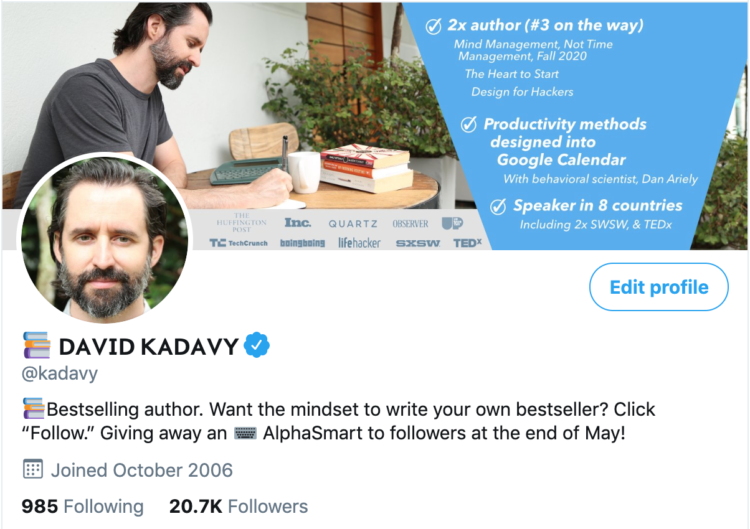
Everything about this profile is aimed at getting followers:
- There are no links on the profile. By the way, if Twitter punishes tweets with links, do they also punish profiles with links?
- I’ve removed clutter from the bio. My birthday doesn’t display, and I’ve removed my location. I’d remove my join date if I could. This is basic design: The fewer distractions there are, the more prominent the call-to-action button (“Follow”) is.
- The bio is focused on what the follower will get. Followers will get tweets that will help them with the mindset they need to write a bestselling book. Super specific. (It’s painful for me to write in such a specific way, but trying it.)
- There’s a call-to-action. I’m specifically telling them to “Click ‘Follow.’”
- The profile banner draws attention to the CTA. The angular blue shape matches Twitter’s default color scheme, and draws attention to the button I want people to click.
- I’m incentivizing them to follow me. I’m giving away an AlphaSmart at the end of the month. If they’re interested in an AlphaSmart, they better follow me, so they don’t miss out. Granted, only weirdos are interested in AlphaSmarts, but they’re at least weirdo writers. It’s different from giving away an iPad, which would attract just about anyone.
I also created a profile banner listing some of my accomplishments. The idea is that if people want to know what they’ll get, they can read the bio. If they want to know more about me, they can look at the banner.
Measuring Twitter profile performance
This is all very hard to test, because measuring the performance of your Twitter profile is a bit of a black box. Twitter only updates the number of your profile visits once a day, and you have to manually count how many new followers you have in that time period. So far, the “conversion rate” varies wildly from one day to the next.
It’s possible that many people follow you without visiting your profile at all. Also, they likely choose to follow you based upon a tweet you wrote, rather than what’s written in the profile. When I have a tweet that does very well, I do see the “conversion rate” jump.
There’s a good chance I’m wasting my time here. Maybe no amount of profile tweaking will improve performance. There’s also a good chance I’m making all of the wrong choices in optimizing my profile. The next thing I’d like to try is to just leave the bio and banner in my profile blank.
Future Twitter profile strategy
At some point, I may change strategy again, and optimize my profile for gaining email subscribers or selling books. But I would want to revive my engagement rate, first.
I also want to either arrive at the point where I know what I’m doing in terms of optimizing a profile, or I’ve concluded that it doesn’t make much difference what I do.
Part of what’s making it difficult to arrive at the right Twitter strategy is there’s still muddy ness in the overall business. Yes, through the success of the self publishing coaching calls I’ve been booking, I am homing on on helping authors. But I’m also writing books about creative productivity that should have a wider appeal than that. For now, I’m experimenting with being as specific as I can, thinking I can get wider, if needed.
Is all of the Twitter obsession working?
So, after obsessing over Twitter for the past four months, am I seeing any improvement at all?
Well, I’ve steadily been increasing my engagement rate:
My Twitter engagement rate:
– February: 1.0%
– March: 1.4%
– April: 2.0%After 14 years, starting to figure this out. pic.twitter.com/wKl77ZQZg6
— ? David Kadavy (@kadavy) May 1, 2020
Also, I lost many followers for the first few months, as I changed course. This is partly to be expected: I’ve changed the things I tweet about. Also, I was writing very few tweets, so I simply had fewer impressions to bring in new followers.
But, after months of losing followers, I’m reversing course. I’m actually gaining followers!
While re-tooling my Twitter strategy, I was hemorrhaging followers for months. So far this month, turning it around:
Feb: -16 ?
Mar: -36 ?
Apr: -66 ?
May: +32 ?This is not random. If you look closely, you can be better at Twitter. pic.twitter.com/wJZs05TQAK
— ? David Kadavy (@kadavy) May 18, 2020
Twitter as a training ground
Now that I’ve gone very deep into something that isn’t related to my core goal for using Twitter, let’s get back to what is related to my core goal of using Twitter: improving my writing.
I regularly check the performance of my tweets. The winners, I record as candidates for expanding into Love Mondays emails. The losers, I delete.
Deleting tweets is painful, so that serves as training to remember that those ideas didn’t resonate. Additionally, this keeps my feed clean. If someone visits my profile, they’ll only see good stuff.
It’s clear that a couple of hot Twitter profiles – James Clear, and Mark Manson – both do something similar. James Clear’s best tweets get copy/pasted into his 3-2-1 Thursday’s newsletter. Mark Manson’s best tweets also show up as text within long-form content in his Mindf*ck Monday newsletter.
Taking a break from interviews
For the first time in the four-year history of my podcast, Love Your Work, I’m taking a break from interviews.
I pride myself in delivering an episode every week, on schedule, for all of this time. Why would I stop?
It’s so I can focus on my upcoming book, Mind Management, Not Time Management.
It was a tough decision to suspend interviews. After all, within the book itself, I talk about managing creative energy to keep consistent with projects such as the podcast.
But, I’ve been working on this book for ten years. It’s totally appropriate, and a wise use of creative energy, to free up some of that energy to bring the book down the home stretch.
I’ll keep doing bi-weekly essay episodes, which will give me a chance to test out some of the ideas that will appear in the book.
A plus side of this break is that it will also free up financial resources. It will reduce production costs by about $160 a month. Since Patreon backing no longer covers all of the production costs, this keeps me from losing money on the show for a bit. I’ll also downgrade to a cheaper Libsyn plan, which will save about $13 a month.
I do plan to bring interviews back, after the book launches in the fall. Interviews are a good way to connect with guests, and they’re a great source of ideas which I can expand upon.
However, honestly, eliminating interviews isn’t completely out of the question. I’ll be thinking about that in the background. For now, I’m focusing on the book.
White Hot Course promotion
I haven’t been investing much in Design for Hackers lately. That’s appropriate, because doing so doesn’t get me closer to my bigger goals. However, I also expend resources maintaining it, including the enormous bill for the large email list.
I realized that I was letting the perfect be the enemy of the good. I didn’t have the energy to do really good product launches, so I didn’t do them at all.
I decided to do a “Pareto” launch. 20% of the effort, for – hopefully – 80% of the results. I did a promotion of my “white space” course, White Hot Course.
So, I sent out three simple emails with a coupon. I brought in $546, $234 of which falls within April. Unfortunately, I didn’t bother making a revenue prediction, to test my forecasting skills.
D4H fat-cutting
I do have on my list to brainstorm some fat-cutting for D4H. Just keeping it in the background is using up some resources. Unfortunately, it’s not as simple as just cutting out some things. Some things depend upon other things, and it all adds up to some work, no matter what course I take. I’ll be thinking about that in the background.
ActiveCampaign payments still off
I got paid $895 by ActiveCampaign, which is about $260 less than what I earned in referrals two months prior.
ActiveCampaign made some accounting adjustments to their affiliate payments early in the year, and that has caused their payments to be either unusually low, or unusually high.
For example, I’ve already gotten paid more than $2,800 in May, which is unusually high.
I thought the payments would have evened out by now, but not yet. In the meantime, it is fun to get payments for $2,800. Hopefully that will be the norm.
Income
Book Sales
Digital Products
| D4H Video | $29 |
| White Hot Course | $234 |
| Summer of Design | $13 |
| Total Digital Products | $276 |
Affiliates / Advertising
| Active Campaign | $895 |
| Amazon | $38 |
| ConvertKit | $76 |
| Google AdSense | $132 |
| SendOwl | $5 |
| Total Affiliates | $1,146 |
Love Your Work Podcast
| Patreon | $234 |
| PayPal Donations | $10 |
| Sponsors | $280 |
| Total LYW Podcast | $524 |
Services
| Medium | $6 |
| Clarity | $151 |
| Total Services | $156 |
| GROSS INCOME | $5,283 |
Expenses
General
| Accounting | $170 |
| Outside Contractors | $127 |
| Podcast Editing / Publishing | $240 |
| Misc. Software | $9 |
| Total General | $546 |
Advertising
| Amazon | $639 |
| Comped books | $13 |
| Total Advertising | $652 |
Hosting
| Bookfunnel | $15 |
| Genius Link | $10 |
| Libsyn | $20 |
| SendOwl | $24 |
| Namecheap | $13 |
| Total Hosting | $82 |
| TOTAL EXPENSES | $1,280 |
| NET PROFIT | $4,003 |


